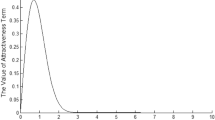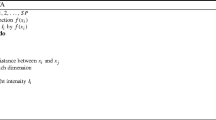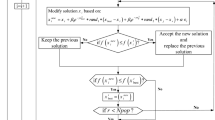Abstract
As a nature-inspired metaheuristic method, the firefly algorithm (FA) arises more attentions in academic and engineering fields. However, too much attraction in FA’s global attraction model leads to low computational efficiency, and the stochastic model with fixed randomization parameter is hard to balance the exploitation and exploration of the algorithm. Thus, FA still needs improvement to deal with complex engineering problems. An integrated firefly algorithm (IFA) that combines two novel attractive models with a new stochastic model is proposed to improve the standard FA. Firstly, the attractive model and stochastic model of standard FA are investigated through theoretical analysis and numerical experiments. And the factors that affect the computational efficiency and accuracy of FA are revealed. Based on the analysis results, two new fitness-based update formulas for attractiveness parameter are constructed to avoid the invalidation. The proposed virtual attractive model and global best attractive model can reduce the computation complexity and enhance the exploitation ability. Moreover, an adaptive strategy is presented for the stochastic model to achieve a better balance between exploitation and exploration. The nonlinearly decreased model for the update of parameter α can adjust the population diversity through the iteration and ensure the convergence. Additionally, an adaptive penalty function method is developed to handle the constraints effectively. Then, the initial parameters are tested, and the best initial parameters corresponding to the optimal performance of IFA are obtained. The proposed algorithm is evaluated by CEC2015 hybrid composition and a set of classical functions. The numerical experimental results show that the proposed techniques can enhance the solution accuracy and accelerate the convergence speed. Finally, IFA and other metaheuristic algorithms are applied to solve five engineering design optimization problems with mixed variables and multiple constraint conditions. The results indicate that IFA with adaptive penalty function needs fewer fitness evaluations and costs less computational time to obtain the optimal solutions. Furthermore, it exhibits better accuracy and robustness than other algorithms.





































Similar content being viewed by others
Data availability
Enquiries about data availability should be directed to the authors.
References
Abualigah L, Diabat A, Mirjalili S, Abd Elaziz M, Gandomi AH (2021) The arithmetic optimization algorithm. Comput Meth Appl Mech Eng 376:113609
Altay ŞY, Ulutaş G (2021) Self-adaptive step firefly algorithm based robust watermarking method in DWT-SVD domain. Multimed Tools Appl 80:23457–23484. https://doi.org/10.1007/s11042-020-10251-7
Arqub OA, Abo-Hammour Z (2014) Numerical solution of systems of second-order boundary value problems using continuous genetic algorithm. Inf sci 279:396–415. https://doi.org/10.1016/j.ins.2014.03.128
Azad SK, Hasançebi O (2014) An elitist self-adaptive step-size search for structural design optimization. Appl Soft Comput 19:226–235. https://doi.org/10.1016/j.asoc.2014.02.017
Baghdadi A, Heristchian M, Kloft H (2020) Design of prefabricated wall-floor building systems using meta-heuristic optimization algorithms. Autom Constr 114:103156. https://doi.org/10.1016/j.autcon.2020.103156
Baghlani A, Makiabadi MH, Sarcheshmehpour M (2016) Discrete optimum design of truss structures by an improved firefly algorithm. Adv Struct Eng 17(10):1517–1530. https://doi.org/10.1260/1369-4332.17.10.1517
Barbosa HJC, Lemonge ACC (2003) A new adaptive penalty scheme for genetic algorithms. Inf Sci 156(3–4):215–251
Baykasoğlu A, Ozsoydan FB (2014) An improved firefly algorithm for solving dynamic multidimensional knapsack problems. Expert Syst Appl 41(8):3712–3725. https://doi.org/10.1016/j.eswa.2013.11.040
Bureerat S, Pholdee N (2016) Optimal truss sizing using an adaptive differential evolution algorithm. J Comput Civ Eng 30(2):04015019. https://doi.org/10.1061/(asce)cp
Carbas S (2016) Design optimization of steel frames using an enhanced firefly algorithm. Eng Optim 48(12):2007–2025. https://doi.org/10.1080/0305215x.2016.1145217
Cheng ZW, Song HH, Wang JQ, Zhang HY, Chang TZ, Zhang MX (2021) Hybrid firefly algorithm with grouping attraction for constrained optimization problem. Knowledge-Based Syst 220(7):106937. https://doi.org/10.1016/j.knosys.2021.106937
Chen X, Zhou Y, Tang Z, Luo Q (2017) A hybrid algorithm combining glowworm swarm optimization and complete 2-opt algorithm for spherical travelling salesman problems. Appl Soft Comput 58:104–114. https://doi.org/10.1016/j.asoc.2017.04.057
Chou JS, Ngo NT (2017) Modified firefly algorithm for multidimensional optimization in structural design problems. Struct Multidiscip Optim 55:2013–2028. https://doi.org/10.1007/s00158-016-1624-x
Das AK, Pratihar DK (2021) Solving engineering optimization problems using an improved real-coded genetic algorithm (IRGA) with directional mutation and crossover. Soft Comput 25(7):5455–5481. https://doi.org/10.1007/s00500-020-05545-9
Deb K (2000) An efficient constraint handling method for genetic algorithms. Comput Methods Appl Mech Eng 186(2–4):311–338
Deb K, Datta R (2010) A fast and accurate solution of constrained optimization problems using a hybrid bi-objective and penalty function approach. In: 2010 IEEE Congress on Evolutionary Computation
Degertekin SO (2012) Improved harmony search algorithms for sizing optimization of truss structures. Comput Struct 92–93:229–241. https://doi.org/10.1016/j.compstruc.2011.10.022
Ding X, Hasanipanah M, Rad HN, Zhou W (2020) Predicting the blast-induced vibration velocity using a bagged support vector regression optimized with firefly algorithm. Eng Comput. https://doi.org/10.1007/s00366-020-00937-9
Dong N, Wang YP (2014) An unbiased bi-objective optimization model and algorithm for constrained optimization. Int J Pattern Recogn Artif Intell 28(8):1459008. https://doi.org/10.1142/S0218001414590083
Erdal F (2017) A firefly algorithm for optimum design of new-generation beams. Eng Optim 49(6):915–931. https://doi.org/10.1080/0305215X.2016.1218003
Farmani R, Wright JA (2003) Self-adaptive fitness formulation for constrained optimization. IEEE Trans Evol Comput 7(5):445–455
Fister IJ, Fister I, Brest J, Yang XS (2012) Memetic firefly algorithm for combinatorial optimization. In: Filipic B, Silc J (eds) Proceedings of the Fifth International Conference on Bioinspired Optimization Methods and their Applications, BIOMA 2012, Bohinj, Slovenia, pp 75–86
Fister I, Fister IJ, Yang XS, Brest J (2013a) A comprehensive review of firefly algorithms. Swarm Evol Comput 13:34–46. https://doi.org/10.1016/j.swevo.2013.06.001
Fister I, Yang XS, Brest J, Fister IJ (2013b) Modified firefly algorithm using quaternion representation. Expert Syst Appl 40(18):7220–7230. https://doi.org/10.1016/j.eswa.2013.06.070
Gálvez A, Iglesias A (2020) Memetic improved cuckoo search algorithm for automatic B-spline border approximation of cutaneous melanoma from macroscopic medical images. Adv Eng Inf 43:101005. https://doi.org/10.1016/j.aei.2019.101005
Gandomi AH, Yang XS, Alavi AH (2011) Mixed variable structural optimization using Firefly Algorithm. Comput Struct 89:2325–2336. https://doi.org/10.1016/j.compstruc.2011.08.002
Gandomi AH, Yang XS, Talatahari S, Alavi AH (2013) Firefly algorithm with chaos. Commun Nonlinear Sci Numer Simul 18(1):89–98. https://doi.org/10.1016/j.cnsns.2012.06.009
Gu L, Yang RJ, Tho CH, Makowski M, Faruque O, Li YH (2001) Optimisation and robustness for crashworthiness of side impact. Int J Vehicle Des 26(4):348–360
Hare W, Nutini J, Tesfamariam S (2013) A survey of non-gradient optimization methods in structural engineering. Adv Eng Softw 59:19–28. https://doi.org/10.1016/j.advengsoft.2013.03.001
Hasançebi O, Azad SK (2015) Adaptive dimensional search: a new metaheuristic algorithm for discrete truss sizing optimization. Comput Struct 154:1–16. https://doi.org/10.1016/j.compstruc.2015.03.014
Hasançebi O, Teke T, Pekcan O (2013) A bat-inspired algorithm for structural optimization. Comput Struct 128:77–90. https://doi.org/10.1016/j.compstruc.2013.07.006
He T, Li D, Yoon SW (2018) An adaptive clustering-based genetic algorithm for the dual-gantry pick-and-place machine optimization. Adv Eng Inf 37:66–78. https://doi.org/10.1016/j.aei.2018.04.007
Hung HL (2017) Application firefly algorithm for peak-to-average power ratio reduction in OFDM systems. Telecommun Syst 65(1):1–8. https://doi.org/10.1007/s11235-016-0208-9
Jordehi RA (2015) A review on constraint handling strategies in particle swarm optimisation. Neural Comput Appl 26:1265–1275. https://doi.org/10.1007/s00521-014-1808-5
Kamarian S, Shakeri M, Yas MH (2017) Thermal buckling optimisation of composite plates using firefly algorithm. J Exp Theoret Artif Intell 29(4):787–794. https://doi.org/10.1080/0952813x.2016.1259267
Karaboga D, Basturk B (2007) A powerful and efficient algorithm for numerical function optimization: artificial bee colony (ABC) algorithm. J Glob Optim 39:459–471. https://doi.org/10.1007/s10898-007-9149-x
Kardani N, Bardhan A, Samui P, Nazem M, Zhou A, Armaghani DJ (2021) A novel technique based on the improved firefly algorithm coupled with extreme learning machine (ELM-IFF) for predicting the thermal conductivity of soil. Eng Comput. https://doi.org/10.1007/s00366-021-01329-3
Kaya S, Gümüşçü A, Aydilek İB, Karaçizmeli İH, Tenekeci ME (2021) Solution for flow shop scheduling problems using chaotic hybrid firefly and particle swarm optimization algorithm with improved local search. Soft Comput 25(10):7143–7154. https://doi.org/10.1007/s00500-021-05673-w
Kennedy J (2010) Particle swarm optimization. In: Sammut C, Webb GI (eds) Encyclopedia of machine learning, 2010th edn. Springer US, Boston, pp 760–766. https://doi.org/10.1007/978-0-387-30164-8_630
Kong D, Chang T, Dai W, Wang Q, Sun H (2018) An improved artificial bee colony algorithm based on elite group guidance and combined breadth-depth search strategy. Inf Sci 442–443:54–71. https://doi.org/10.1016/j.ins.2018.02.025
Kudela J, Matousek R (2022) Recent advances and applications of surrogate models for finite element method computations: a review. Soft Comput 26:13709–13733. https://doi.org/10.1007/s00500-022-07362-8
LaTorre A, Molina D, Osabac E, Poyatos J, Ser JD, Herrera F (2021) A prescription of methodological guidelines for comparing bio-inspired optimization algorithms. Swarm Evol Comput 67:100973. https://doi.org/10.1016/j.swevo.2021.100973
Li LJ, Huang ZB, Liu F (2009) A heuristic particle swarm optimization method for truss structures with discrete variables. Comput Struct 87:435–443. https://doi.org/10.1016/j.compstruc.2009.01.004
Liang JJ, Qu BY, Suganthan PN, Chen Q (2014) Problem definitions and evaluation criteria for the CEC 2015 competition on learning-based real-parameter single objective optimization, Tech. Rep. 201411A, Computational Intelligence Laboratory, Zhengzhou University, Zhengzhou China and Technical Report, Nanyang Technological University, Singapore
Liu JJ, Teo KL, Wang XY, Wu CZ (2016) An exact penalty function-based differential search algorithm for constrained global optimization. Soft Comput 20:1305–1313. https://doi.org/10.1007/s00500-015-1588-6
Meng Z, Zhang ZH, Zhang DQ, Yang DX (2019) An active learning method combining Kriging and accelerated chaotic single loop approach (AK-ACSLA) for reliability-based design optimization. Comput Meth Appl Mech Eng 357:112570. https://doi.org/10.1016/j.cma.2019.112570
Meng Z, Li G, Wang X, Sait SM, Yıldız AR (2021) A comparative study of metaheuristic algorithms for reliability-based design optimization problems. Arch Comput Methods Eng 28(3):1853–1869. https://doi.org/10.1007/s11831-020-09443-z
Mezura-Montes E, Coello CAC (2005) A simple multimembered evolution strategy to solve constrained optimization problems. IEEE Trans Evol Comput 9(1):1–17
Mirjalili S (2016) SCA: a sine cosine algorithm for solving optimization problems. Knowl-Based Syst 96:120–133
Mirjalili S, Mirjalili SM, Lewis A (2014) Grey wolf optimizer. Adv Eng Softw 69:46–61. https://doi.org/10.1016/j.advengsoft.2013.12.007
Mohanty DK (2016) Application of firefly algorithm for design optimization of a shell and tube heat exchanger from economic point of view. Int J Therm Sci 102:228–238. https://doi.org/10.1016/j.ijthermalsci.2015.12.002
Othman MM, El-Khattam W, Hegazy YG, Abdelaziz AY (2016) Optimal placement and sizing of voltage controlled distributed generators in unbalanced distribution networks using supervised firefly algorithm. Int J Electr Power Energy Syst 82:105–113. https://doi.org/10.1016/j.ijepes.2016.03.010
Pan Y, Chen L, Wang J, Ma H, Cai S, Pu S, Duan J, Gao L, Li E (2021) Research on deformation prediction of tunnel surrounding rock using the model combining firefly algorithm and nonlinear auto-regressive dynamic neural network. Eng Comput 37(2):1443–1453. https://doi.org/10.1007/s00366-019-00894-y
Peng H, He Y, Deng C, Wu Z (2019) Firefly Algorithm With Luciferase Inhibition Mechanism. IEEE Access 7:120189–120201. https://doi.org/10.1109/ACCESS.2019.2937136
Rosić MB, Simić MI, Pejović PV (2021) An improved adaptive hybrid firefly differential evolution algorithm for passive target localization. Soft Comput 25(7):5559–5585. https://doi.org/10.1007/s00500-020-05554-8
Runarsson TP, Yao X (2000) Stochastic ranking for constrained evolutionary optimization. IEEE Trans Evol Comput 4(3):284–294
Sadollah A, Bahreininejad A, Eskandar H, Hamdi M (2012) Mine blast algorithm for optimization of truss structures with discrete variables. Comput Struct 102–103:49–63. https://doi.org/10.1016/j.compstruc.2012.03.013
Sattar D, Salim R (2021) A smart metaheuristic algorithm for solving engineering problems. Eng Comput 37:2389–2417
Takahama T, Sakai S (2005) Constrained optimization by applying the alpha constrained method to the nonlinear simplex method with mutations. IEEE Trans Evol Comput 9(5):437–451
Tang Z, Zhou Y (2015) A glowworm swarm optimization algorithm for uninhabited combat air vehicle path planning. J Intell Syst 24(1):69–83. https://doi.org/10.1515/jisys-2013-0066
Tao R, Meng Z, Zhou HL (2021) A self-adaptive strategy based firefly algorithm for constrained engineering design problems. Appl Soft Comput 107:107417. https://doi.org/10.1016/j.asoc.2021.107417
Tessema B, Yen GG (2009) An adaptive penalty formulation for constrained evolutionary optimization. IEEE Trans Syst Man Cybern Part A-Syst Hum 39(3):565–578
Wang H, Wang WJ, Sun H, Rahnamayan S (2016) Firefly algorithm with random attraction. Int J Bio Inspired Comput 8(1):33–41. https://doi.org/10.1504/ijbic.2016.074630
Wang H, Cui Z, Sun H, Rahnamayan S, Yang XS (2017a) Randomly attracted firefly algorithm with neighborhood search and dynamic parameter adjustment mechanism. Soft Comput 21(18):5325–5339
Wang H, Wang W, Zhou X, Sun H, Zhao J, Yu X, Cui Z (2017b) Firefly algorithm with neighborhood attraction. Inf Sci 382–383:374–387. https://doi.org/10.1016/j.ins.2016.12.024
Wu SJ, Chow PT (1995) Steady-state genetic algorithms for discrete optimization of trusses. Comput Struct 56(6):979–991
Xue Y, Jiang J, Zhao B, Ma T (2017) A self-adaptive artificial bee colony algorithm based on global best for global optimization. Soft Comput 22(9):2935–2952. https://doi.org/10.1007/s00500-017-2547-1
Yang XS (2010a) Firefly algorithm, stochastic test functions and design optimisation. Int J Bio Inspired Comput 2:78
Yang XS (2010b) Firefly algorithm, Levy flights and global optimization. Research and Development in Intelligent Systems XXVI. Springer, London, pp 209–218
Yang XS (2014) Nature-inspired optimization algorithm. Nature-inspired optimization algorithm, 1st edn. Elsevier, London, pp 111–127
Yang XS (2018) Nature-Inspired algorithms and applied optimization. Nature-inspired algorithms and applied optimization, vol 744, 1st edn. Springer, Cham, pp 245–259
Yelghi A, Köse C (2018) A modified firefly algorithm for global minimum optimization. Appl Soft Comput 62:29–44. https://doi.org/10.1016/j.asoc.2017.10.032
Yildiz AR, Abderazek H, Mirjalili S (2020) A comparative study of recent non-traditional methods for mechanical design optimization. Arch Comput Methods Eng 27:1031–1048. https://doi.org/10.1007/s11831-019-09343-x
Yu SH, Zuo XK, Fan XL, Liu ZY, Pei MJ (2021) An improved firefly algorithm based on personalized step strategy. Computing 103:735–748. https://doi.org/10.1007/s00607-021-00919-9
Zainuddin Z, Ong P (2016) Optimization of wavelet neural networks with the firefly algorithm for approximation problems. Neural Comput Appl 28:1715–1728. https://doi.org/10.1007/s00521-015-2140-4
Zhang M, Luo W, Wang XF (2008) Differential evolution with dynamic stochastic selection for constrained optimization. Inf Sci 178(15):3043–3074
Zhang H, Tang L, Yang C, Lan SL (2019) Locating electric vehicle charging stations with service capacity using the improved whale optimization algorithm. Adv Eng Inf 41:100901. https://doi.org/10.1016/j.aei.2019.02.006
Zhao J, Chen WP, Ye J, Wang H, Sun H, Lee I (2020) Firefly algorithm based on level-based attracting and variable step size. IEEE Access 8:58700–58716. https://doi.org/10.1109/ACCESS.2020.2981656
Zhou J, Nekouie A, Arslan CA, Pham BT, Hasanipanah M (2020) Novel approach for forecasting the blast-induced AOp using a hybrid fuzzy system and firefly algorithm. Eng Comput 36(2):703–712. https://doi.org/10.1007/s00366-019-00725-0
Funding
This research is supported by the National Natural Science Foundation of China No. 11672098.
Author information
Authors and Affiliations
Contributions
The individual contributions and obligations were made by the following authors. RT contributed to conceptualization, methodology, investigation, software, validation, writing—original draft, review and editing. HLZ contributed to conceptualization, supervision, funding acquisition, project administration, writing—review and editing. ZM contributed to conceptualization, co-supervision, writing—review and editing, and ZTL contributed to review and editing.
Corresponding author
Ethics declarations
Conflict of interest
All authors declare that they have no conflict of interest.
Ethical approval
This article does not contain any studies with human participants or animals performed by the author.
Informed consent
All authors have agreed with the content and all have given explicit consent to publish.
Additional information
Publisher's Note
Springer Nature remains neutral with regard to jurisdictional claims in published maps and institutional affiliations.
Appendices
Appendix A: Spur speed reducer design
where 2.6 ≤ x1 ≤ 3.6, 0.7 ≤ x2 ≤ 0.8, 17 ≤ x3 ≤ 28, 7.3 ≤ x4, x5 ≤ 8.3, 2.9 ≤ x6 ≤ 28, 5.0 ≤ x7 ≤ 5.5.
Appendix B: Vehicle side impact design
Minimize:\(f({\mathbf{x}}) = Weight.\)
Subject to:
\(g_{2} ({\mathbf{x}}) = VC_{u} \left( {\text{dummy upper chest}} \right) \le 0.32{\text{m/s,}}\)
\(g_{4} ({\mathbf{x}}) = VC_{l} \left( {\text{dummy lower chest}} \right) \le 0.32{\text{m/s,}}\)
\(g_{6} ({\mathbf{x}}) = \Delta_{mr} \left( {\text{middle rib deflection}} \right) \le 32{\text{mm,}}\)
\(g_{8} ({\mathbf{x}}) = F_{p} \left( {\text{Pubic force}} \right) \le 4{\text{kN,}}\)
\(g_{10} ({\mathbf{x}}) = V_{{{\text{FD}}}} \left( {\text{Velocity of front door at V - Pilar}} \right) \le 15.7{\text{mm/ms}}{.}\)
To simplify the analytical formulation of the optimization problem and speed up computations, the structural weight and response to impact can be approximated using global response surface methodology. The simplified models are defined as follows:
where 0.5 ≤ x1, x3, x4 ≤ 1.5, 0.45 ≤ x2 ≤ 1.35, 0.875 ≤ x5 ≤ 2.625, 0.4 ≤ x6, x7 ≤ 1.2, x8, x9 ∈ {0.192, 0.345}, -30 ≤ x10, x11 ≤ 30.
Rights and permissions
Springer Nature or its licensor (e.g. a society or other partner) holds exclusive rights to this article under a publishing agreement with the author(s) or other rightsholder(s); author self-archiving of the accepted manuscript version of this article is solely governed by the terms of such publishing agreement and applicable law.
About this article
Cite this article
Tao, R., Zhou, H., Meng, Z. et al. An integrated firefly algorithm for the optimization of constrained engineering design problems. Soft Comput 28, 3207–3250 (2024). https://doi.org/10.1007/s00500-023-09305-3
Accepted:
Published:
Issue Date:
DOI: https://doi.org/10.1007/s00500-023-09305-3




